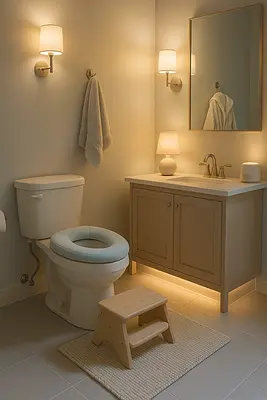Potty training can feel overwhelming for any parent, but when your little one has sensory processing differences, it can seem like navigating uncharted territory. If you're reading this, you're likely wondering how to make the bathroom a comfortable, welcoming space for your sensory-sensitive child. Take a deep breath – you're not alone in this journey, and with patience, understanding, and the right strategies, you can help your child succeed.
Understanding Sensory Challenges in the Bathroom
Children with sensory processing differences experience the world more intensely than others. The bathroom, with its unique textures, sounds, smells, and sensations, can be particularly challenging. Your child might be sensitive to:
- The cold toilet seat against their skin
- The sound of flushing or running water
- The echo in tiled bathrooms
- Bright overhead lighting
- The feeling of their feet dangling
- Different textures of toilet paper
- The sensation of elimination itself
Remember, these aren't behavioral issues – they're genuine sensory experiences that can feel overwhelming or even frightening to your child.
Creating a Sensory-Friendly Bathroom Environment
Temperature and Comfort
Start by making the physical space more welcoming. A padded toilet seat or toilet seat warmer can eliminate the shock of cold porcelain. Consider keeping the bathroom at a comfortable temperature, and have a small blanket or robe nearby for extra warmth and comfort.
Lighting Adjustments
Harsh fluorescent lights can be jarring for sensitive children. Try using softer lighting options like a small lamp, dimmer switches, or even battery-operated LED strips that provide gentle illumination without overwhelming brightness.
Sound Management
If your child is sensitive to bathroom sounds, consider: - Playing soft background music or white noise - Using a toilet with a quieter flush mechanism - Letting them wear noise-reducing headphones initially - Practicing with flushing sounds when they're not on the toilet first
Foot Support and Positioning
Dangling feet can create anxiety and make it harder to relax. A sturdy step stool that allows your child's feet to rest flat can make an enormous difference in their comfort and confidence.
Gradual Exposure and Desensitization
Start Small
Begin by simply spending time in the bathroom together without any pressure to use the toilet. Read books, sing songs, or play quiet games. This helps your child associate the space with positive experiences.
Practice Sitting Clothed
Before expecting your child to sit on the toilet without clothes, let them practice sitting fully clothed. This reduces the number of new sensations they're experiencing at once.
Sensory Exploration
Allow your child to explore bathroom textures and sensations at their own pace. Let them touch the toilet paper, feel the water temperature, or even flush the toilet themselves when they're ready.
Addressing Specific Sensory Needs
For Tactile Sensitivities
- Experiment with different types of toilet paper or wet wipes
- Consider using a potty seat insert for a more familiar feeling
- Let your child choose special "potty underwear" that feels good to them
- Use hand-over-hand guidance to help them get used to wiping motions
For Auditory Sensitivities
- Create a "bathroom playlist" of calming songs
- Use visual cues instead of verbal instructions when possible
- Practice bathroom sounds during non-potty times
- Consider a white noise machine to mask sudden sounds
For Visual Sensitivities
- Use consistent, gentle lighting
- Minimize visual clutter in the bathroom
- Consider using a potty chair in a less stimulating room initially
- Use visual schedules with simple, clear pictures
Building Positive Associations
Routine and Predictability
Children with sensory differences often thrive on routine. Establish a consistent potty routine with the same steps in the same order. This predictability can be incredibly comforting.
Sensory Rewards
Traditional sticker charts might not motivate your sensory-sensitive child. Instead, consider sensory-based rewards like: - A few minutes with a favorite fidget toy - Listening to a preferred song - A gentle hand massage with lotion - Time with a weighted lap pad
Celebrate Small Wins
Every step forward deserves recognition, whether it's sitting on the toilet for 10 seconds, trying a new bathroom, or simply entering the bathroom without distress.
Working with Your Child's Unique Timeline
It's crucial to remember that children with sensory processing differences often need more time to adjust to new experiences. What might take a neurotypical child weeks to master could take your child months – and that's perfectly okay.
Don't compare your child's progress to others. Instead, celebrate their individual journey and the courage it takes for them to navigate sensory challenges every day.
When to Seek Additional Support
If you're feeling stuck or if your child's sensory challenges seem overwhelming, don't hesitate to reach out for professional support. Occupational therapists who specialize in sensory processing can provide invaluable strategies tailored to your child's specific needs.
Supporting Your Whole Family
Remember to take care of yourself during this process. Potty training a sensory-sensitive child can be emotionally and physically exhausting. Connect with other parents who understand your journey, and don't be afraid to ask for help when you need it.
Your patience, understanding, and unconditional love are the most powerful tools you have. Trust in your child's ability to succeed, even if their path looks different from others.
Making It Easier with Technology
Consider using the Potty Whiz app to help streamline your potty training journey. This family-friendly app allows all caregivers to collaborate by logging potty activities, tracking progress, and setting gentle timers and reminders. For children with sensory needs who thrive on routine and predictability, having consistent tracking across all caregivers can be especially helpful in maintaining the structure that supports their success.
Remember, every child is unique, and what works for one may not work for another. Trust your instincts as a parent, celebrate small victories, and know that with time and patience, your sensory-sensitive child will master this important milestone.






